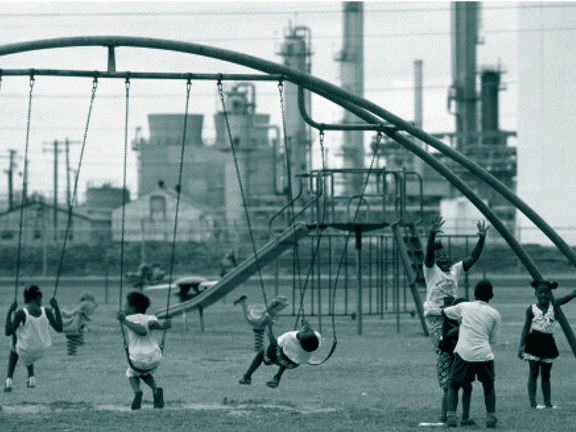PVC: health costs, environmental justice, why we seem to love it

The spirit of the two images above could not be more disparate. In one, the sun sets on Rubber Duck, an installation in the Netherlands by artist Florentijn Hofman. His site proclaims: "the Rubber Duck knows no frontiers, doesn't discriminate people and doesn't have a political connotation." Rubber Duck has "traveled"-- or rather been reproduced around the world, including in the US (although with some controversy). The other photograph shows a somber image of a Lousiana town near a chemical plant producing Polyvinyl Chloride, the material from which Rubber Duck is made.
Programs like LEED and the Living Building Challenge push us designers to question the seemingly innocuous decisions we make on a daily basis. In particular, we are more aware of a building's impacts beyond the most immediate performance and aesthetic desires. Awareness of the complexity doesn't often make our choices easier. Nevertheless, we realize that, conscious or not, even the simple act of choosing a particular material speaks to our priorities as a culture.
It's nothing new. The same companies that provided steel at a low price to designers and developers who wanted to push the envelope on building height kept workers' wages low and did little to protect them against the deadly consquences of working in the industry. Nevertheless, steel production also created jobs and a higher quality of life for many, while boosting national prestige. Going back further inhistory, the Great Wall of China is known to have entombed the bodies of many of its builders. The orchestration of ideas and people has always been part of the architect's balancing act.
By understanding what is happening "upstream" of our receipt of a particular product, designers can begin to make decisions that will have a market impact. As we seek to specify low toxicity building materials, architects' intend to reward product manufacturers with better practices and chemical compositions over those with more controversial ones. By making preferential selections, designers can guide the innovation of those industries beyond the bottom line. Innovations creating building materials will encourage reporting that will lead to evaluation to ensure reporting accuracy. Through positive evaluations, architect's can make more informed selections and the cycle will continue, making incremental changes in the market.
But back to the topic at hand, PVC. Its use in our building materials is copious. Its by-products are toxic, causing many health hazards including cancer, disruption of the endocrine system, reproductive impairment, impaired child development and birth defects, neurotoxicity and immune system suppression. In addition to their toxicity, the by-products of polyvinyl chloride are persistent or resistant to natural degradation and bioaccumulative or fat-soluble and therefore building up in the tissues of living things.
The biggest chemical concerns are as follows:
Dioxin, a potent synthetic carcinogen. It is formed throughout the vinyl lifecycle, wheneveran accidental fire occurs and whenever vinyl products are incinerated. "Toxicological studies have not been able to establish a 'threshold' dose below which dioxin does not cause biological impacts."
Phthalate plasticizers, which are used to make flexible vinyl products, damage reproduction and development. More than 5 million tons of phthalates are used in vinyl every year and the vinyl industry accounts for 90% of phthalate production. Over time, they leach out of vinyl through air and water, and phthalate accumulation occurs in indoor dusts at concentrations as high as 1,000 parts per million.
Chlorine, lead, and mercury are other hazardous materials involved in PVC production.
Some of the advantages of PVC are difficult to protest. An investigation into flooring possibilities for hospital patient rooms yielded PVC and linoleum as "highly recommended" with rubber as only "recommended" most likely due to the restrictive cleaning requirements and penetration requirements of floors in such spaces. As an affordable building material, it has also been used for lesser served populations and was the main material for the above "Sphere Refugee Tent" designed by Formstark in Koln, Germany. The PVC allowed for a lightweight, waterproof structure.
Because of its high environmental and health costs, designers must push for change and seek alternatives to PVC. The issue is particularly potent here in Louisiana where many of the PVC chemical companies sit along the Missippi. Reveilletown, LA, a small town formed by former slaves of 106 residents pictured above was quietly evacuated in 1988 when chemical company Georgia Gulf faced residents' complaints of health problems as a result of a vinyl chloride plume in groundwater. Similar environmental concerns grew in Morrisonville, Louisiana and Mossville, Louisiana, where blood levels of dioxins average almost three times those of a comparison population.
Some of these stories and systems are described in the recent Petrochemical America. A collaborative book of landscape architect Kate Orff and photographer Richard Misrach.
http://www.southernspaces.org/2013/petrochemical-america-petrochemical-addiction
What's next?
Keep in mind that PVC is listed on the LBC Red List. As much as we can choose alternatives to PVC, we should. PVC-free carpet backings are common, and other than in hospital patient rooms, rubber serves as a great substitute to vinyl. Understanding the inherent health consequences involved with the production of PVC, the price upgrade can be worthwhile, especially when maintenance costs are considered. The most difficult materials to retire PVC is in connection pieces and pipes, so while a complete overhaul of the system may not be possible, incremental change is in our power.
Resources
Read the complete article on PVC's environmental and health hazards here:
To learn about what PVC supporters think, visit:

